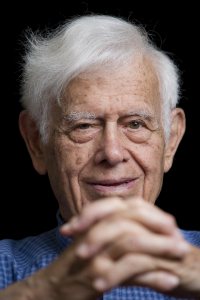
Bates in the News: Jan. 16, 2015

Frank Glazer, photographed at his home in Topsham, Maine, in 2006. (Phyllis Graber Jensen/Bates College)
Frank Glazer
The death of Frank Glazer, renowned pianist, Bates artist in residence and lecturer in music, on Jan. 13 at age 99 prompted coverage from a number of media outlets, including the Portland Press Herald.
Reporter Bob Keyes spoke to Jim Parakilas, the Moody Family Professor of Performing Arts, who said:
“His physical presence changed over the years but his playing remained unbelievable. He was so fast and spectacular. What happened over the years — he didn’t have the strength and speed that he had when he was younger, but instead there was a kind of translucence to his playing where you could hear everything. The message of the music came out with a kind of simplicity that was unmistakable.”
Keyes also quoted one of Glazer’s students, Duncan Cumming ’93, now a concert pianist and assistant professor of music at the University at Albany:
“He played with the strength and virtuosity of a man half his age or a third his age, but with the experience of a man 99 years old…. He just got better and better and better, because he worked at it for so much longer than anyone in the history of the world.”
 Deborah Hansen ’89
Deborah Hansen ’89
Deborah Hansen ’89 was quoted at the top of a Boston Globe story about sparkling wines. Reminiscent of the old spaghetti commercial, the story suggests that every day can be sparkling wine day.
“Wine professionals are happy to recommend sparkling wines for New Year’s Eve, but are even more thrilled when customers ask about these quaffs beyond Jan. 1,” writes correspondent Ellen Bhang.
Hansen, the chef-owner-sommelier of Taberna de Haro in Brookline, “thinks wine drinkers should follow the example of Catalan residents of northeastern Spain,” Bhang writes, who “enjoy the sparkler cava any time of day.”
Says Hansen, “It’s common to have a glass in the afternoon when friends come over.”
Hansen suggests a couple of cavas, including Reserva de la Familia, a “brut nature” from family-owned Juve y Camps, located in the region of Penedes, near Barcelona.
“Only 6 percent of cavas made are grower cavas,” Hansen explains, noting that enthusiasts should look for these special pours because they offer “character, verve, and pedigree,” unlike the large commercial brands.
Graham Safford ’15

Graham Safford ’15 scored his 1,000th career point in Bates’ 60-55 victory over Brandeis University on Jan. 6 in Alumni Gym. (Phyllis Graber Jensen/Bates College)
“He is, no question, the most competitive kid that I’ve ever coached, worked with, been around,” Bates men’s basketball coach Jon Furbush ’05 tells the Bangor Daily News, which published a story about how point guard Graham Safford ’15 has worked through the death of his father, of cancer, four years ago on Christmas Day.
“I think it was a sign that, on Christmas Day, it eased all his pain and he was able to go to a better place,” Safford tells BDN reporter Pete Warner, who writes that “having been confronted with the fragility of life, Safford committed himself to seizing the day.”
Safford, from Hampden, Maine, is one of four Bates captains. He scored his 1,000th career point on Jan. 6 in the Bobcats’ victory over Brandeis at Alumni Gym.
“Every time I play, I want to give everything I’ve got out there. That pertains to all aspects of life.”
Bill Hiss ’66 and Valerie Wilson Franks ’98
An excerpt of Lani Guinier’s book The Tyranny of the Meritocracy: Democratizing Higher Education in America published in Salon includes mention of the 2014 report by Bill Hiss ’66 and Valerie Wilson Franks ’98 that found that standardized tests do not accurately predict college success. She quotes Hiss and Franks:
“Many of us who have spent our careers as secondary and university faculty and administrators find compelling the argument that ‘what students do over four years in high school is more important than what they do on a Saturday morning.’”
President Spencer
Late in 2014, Clayton Spencer was quoted by The Wall Street Journal on the Obama plan to rank the nation’s 5,000-plus colleges and universities according to various metrics, including graduation and retention rates; the ability of their graduates to pay back their student loans; and the schools’ accessibility to low-income and first-generation students.
Reporter Douglas Belkin notes that “few in academia believe there is an equitable way to rate so many schools; they say whatever variables are selected will necessarily skew the ratings in that direction.”
Spencer says that “you just cannot compare [the broad variety of schools] coherently…. You need to compare them in a mission-specific way.”

Paper masks used in shaman rituals of the Yao people of Vietnam. From the Museum of Art exhibition “How to Make the Universe Right.”
Bates Museum of Art
The Santa Barbara Independent reviewed the exhibition of shaman scrolls and an extensive array of ceremonial objects developed and curated by the Bates College Museum of Art and premiered here in 2014.
How to Make the Universe Right: The Art of the Shaman in Vietnam and Southern China is now at the University of California–Santa Barbara’s Art, Design & Architecture Museum.
Research by Trian Nguyen, a Bates assistant professor of art and the Luce Junior Professor of Asian Studies, forms the scholarly foundation for the show.
His research, says the Independent, affords a “fascinating glimpse of the intensity required” to keep alive for millennia the ritual shamanistic traditions.
Bates Museum of Art director Dan Mills curated the exhibition in conjunction with Nguyen and Barry Kitnick of Santa Barbara, from whose collection the show was assembled.

“Startrails,” a 2011 inkjet print by Yuichi Takasaka, is one of the astrophotographs in the exhibition “Starstruck.”
Meanwhile, another exhibition developed by the Bates museum continues to collect stars on its crown.
The Philadelphia Inquirer says that seeing Starstruck: The Fine Art of Astrophotography, now showing at the James A. Michener Art Museum in Doylestown, Pa., is among the top five things to do in the region.
The Times of Trenton, N.J., quotes Anthony Shostak, the curator of education at Bates museum who organized the show:
The images “are nothing less than overwhelming—depicting humbling, glorious delights that are often invisible to both the naked eye and even the telescope, and are revealed only through photographic means.”




